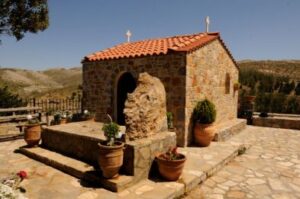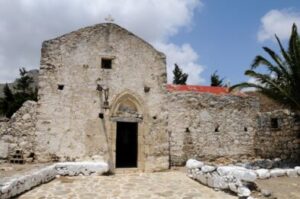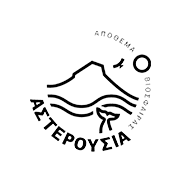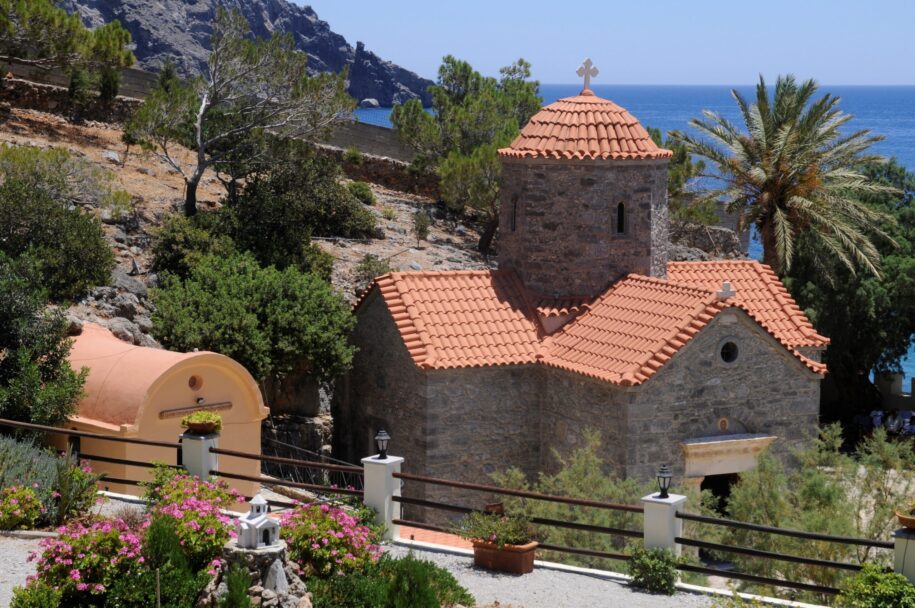Agios Oros of Crete
The reference of the Evangelist John to the meeting of Christ with the Greeks shows the identification of the Greeks with Orthodoxy. There were also some Greeks from among those who were resurrected, in order to worship in the feast. They therefore came to Philip from Bethsaida of Galilee, and asked him, saying: Lord, we want to see Jesus. Philip comes and says to Andrew, and again Andrew and Philip say to Jesus. And Jesus answered them, saying, The hour is come, that the Son of human. It may be that during these 2000 years, through adverse and difficult circumstances, Hellenism experienced disasters, lost a large part of its territory and its power, but it did not lose its Faith, its Faith in the True God. We see this in every part of our country, where there are everywhere Churches and chapels in the most unlikely and remote parts of the territory. We also understand that Greeks passed from one place, seeing the existence of a Church in the most central part of the area. The love of the Greeks for Orthodoxy can also be seen in the mountains, where on more of their peaks we find Monasteries, Churches and names of the peaks with names of our Saints. Some of them are: On the highest mountain, Olympus, at an altitude of 2803 m, the peak of “Prophet Ilias”. Mount Athos needs no introduction, just like Meteora. In all the islands of the Aegean Sea and the Ionian Sea, the first thing you see from their ports is the Church at the top of the island. (Amorgos “Panagia Chozoviotissa”, Kalymnos “Holy Monastery of All Saints and Agios Savvas the New”, Tilos “Holy Monastery of Agios Panteleimonos”, etc.) Outside of this love for our Orthodoxy, the largest island could not remain of Greece, Crete. Here we have an abundance of Historical Monasteries, from Historic Churches and from Askitaria. But we will stay in one mountain, the Asterous Mountains, which formed the Mount Dikty of the Minoans, the sacred mountain of the Classics and the Holy Mountain of the Christians. We will deal with the third section. Asterousia was blessed to be the first place that was visited by the Apostle Paul in Crete and is also mentioned in the Apostolic Epistles to Titon “For this reason I left you in Crete, so that you may repair what is missing and make elders in each city.” The Apostle Paul arrived in Crete, when during his journey to Rome he suffered from a terrible shipwreck and those on board were in danger for fourteen days and nights, until they landed with relief at the Good Ports of Crete. From that moment on, the mountain that rises above Kalous Limenes to become agiotokon and herootokon. The seed left by the Apostle Paul found suitable soil in Asterousia and its inhabitants immediately embraced the Christianity. Their Love immediately brought in the first centuries martyrs who for their faith in Christ sacrificed their lives and did not give in to the threats of the Roman rulers. In the 3rd century AD, during the period of the Roman Emperors Decius, Diocletian and Maximilian, Constantine V Surname etc. we have the first ones who were martyred by horrible tortures: The Ten Saints, the Bishop of Gortynas Kyrillos in 299 AD. and the Bishop also Gortynas Petros at the beginning of the 4th century. Also Saint Paul, Saint Andreas “the one in crisis” etc. After the cessation of persecutions, the neophotist Christians, freed from the fear of persecutions, built many Royal Churches. During the archaeological excavations they were located on all the southern coasts of Asterousia and in historical sites of Asterousia such as Levina, Inatos, Raxos, Agioi Eftichianoi, Agios Kyrillos, Kali Limenes, Tsoutsouras, Harakas, the Castellian early Christian basilicas that the Christians of the time had brightened with all the material goods there was but also with a lot of Love. During the first Byzantine period, he found Orthodoxy in Asterousia in great spiritual development, the result of which was the emergence of great Saints of the Church, such as (indicatively) Bishops Kyrillos, Eumenios, Eutychianos and a large series of holy figures. The leader of all of them was Agios Andreas of Crete, who used to resort to Asterousia to be quiet and inspired. In fact, it is assumed that in Asterousia he composed his masterpiece “The Great Rule” and “My soul, my soul, rise” was heard for the first time.
A natural consequence of all this was the appearance of monasticism on the mountain. Due to the fact that Asterousia was not developed residentially, it found fertile ground for the development of monasticism, which is why it received a great spiritual dimension and a gathering of monks from Crete and beyond. Conovian Holy Monasteries were founded, such as the Holy Monastery of Eftykhianon in the 10th century, the Holy Monastery of Zoodochos Pigi in Kapetaniana (13th century), the Holy Monastery of Agios Ioannis Kapetaniano (13th century), the Holy Monastery of Agios Dimitrios Ahentria (13th century), Monastery of the Three Hierarchs (Filagri) in Lousoudi (14th century), Holy Monastery of Odegitria (14th century), Holy Monastery of Panagia Koudouma (14th century), Holy Monastery of Agios Pavlos Paranymphon (14th century), Holy Monastery of Agios Nikitas (14 -15th century), Holy Monastery of Apezanon in Antiskari (16th century) where many believers find refuge as well as many ascetics who found refuge in the innumerable caves and caverns of the mountain. The love and true faith of the monks can be seen to this day from the finds found in the caves and caves of Asterousia. During the period of Venetian rule in Crete, an idiosyncratic and coercive union was created which was imposed by the Vatican. The Conquerors, and especially the Vatican, thought that the only way to control the Cretans was to change their national mentality. The way to do this was to cut them off from Orthodoxy. At that time, many brilliant clergy found refuge in the Asterousia Mountains, from where they began their spiritual activity. Then the Dissenting Theologians appeared on the island, who with unparalleled love and faith through the caves and Holy Monasteries that existed in Asterousia, guided the Orthodox Christians. The leader of all was Iosif Filargis or Filagrios, originally from Khandaka. To him the Patriarchate of Constantinople gave its title “Teacher and Lawyer of Crete”, whose purpose was to preserve the faith, language and national identity of the Cretans. In the middle of the 14th century he left the city and settled in Asterousia. In Lousoudi, an inaccessible and remote place, he founded the Monastery of the Three Hierarchs, where he himself settled with a significant number of disciples. In this school of Filargios, philosophy, rhetoric, grammar, dogma, words of the wise were taught. However, he gave special importance to the ancient writers, especially Plato and Aristotle. The most important achievement of his school was the Noera Prayer, “Lord Mercy”, which was compiled by one of the last great Theologians and Fathers of the Church before the Fall of the City, Joseph Bryennios, a fellow traveler of Philargios. The activity of Philargios is of incalculable importance. When all of Europe was in the Middle Ages, a monk in remote Asterousia was teaching, annotating and spreading Aristotle. Thus the persecutions of the Venetians gave rise to a brilliant spiritual growth in the remote, but also blessed by the Apostle of the Nations, Asterousia Mountains. This brilliant course was violently interrupted when the Ottomans conquered Crete. Asterousia became a battlefield, as the last defenders took refuge in them, hidden in the dense vegetation of the multifaceted mountains. For ten consecutive years, the Turks burned the Asterousian forests, stripping them bare so that they could control the Chainids. The monasteries were destroyed and only two remained: those of Apezan and the Holy Monastery of Odigetria. In the 19th century, the monasticism of Asterousia took a different form. The monk turned into a warrior. It is the time when those who could not tolerate the conqueror took refuge in the monasteries of Asterousia. Monasticism became an act of resistance. The captain monks took part in all the great revolutions. A leading case is Ioasaf Markakis from Asterousia, the legendary Xopateras, who will give the Odegitria Monastery the most paradoxical battle in history: One against thousands from the tower of the Monastery which is preserved to this day. During the period of the occupation of Crete by the Germans, the Asterousia Mountains, due to their position, played an important role. From him they were not left out again the Monks of the Holy Monasteries but also of the Ascetics. The resistance fighters who had been proclaimed by the Germans arrived there and found refuge in the Monasteries and Ascetics of the Asterousians. From there many fled to the Middle East and Egypt, where the Germans had not arrived. Today Asterousia is a beautiful place to visit that will make you love it and will become a place you will visit again and remains one of the greatest spiritual centers not only in Greece but throughout the world. For these and many other reasons, UNESCO included the Mountains in the World Network of Areas “Man and Biosphere”.
There are three Holy Monasteries active today: The Holy Monastery of Odigetria, which apart from Agios Antonios in Agiofaragos and Panagia in Martsalos, in its area there are also a number of chapels and hermitages, where each one has an important history and is connected to the life of Saints Ascetics and Saints who lived in the area. These are: The Cave Church of Agia Kyriaki, the Church of Agios Apostolos Andreas, the Saints Eftychianoi (former Holy Monastery of Saints Eftychios and Eftychianos), Agios Ioannis “Vathy Lagos” and the Holy Church of the Holy Cross, at the highest point of Asterousi, on the Holy Peak of Kofina. She is second. The Holy Monastery of Panagia Koudouma is a Historical Monastery that has a significant number of chapels and cavernous Churches such as the Holy Church of Agios Nikolaos, the Holy Monastery of the Three Hierarchs of Lousoudi, of Agios Basilios Bishop of Gortyni (Kithion area), of Agios Kosmas the Hermit (cave temple in Avvakospilio, near the Monastery), All of the Osias and Theophores shining in practice of Our Fathers (cave temple, near the Monastery) as well as other caves of great historical importance. Third is the Holy Monastery of Apezanon in Antiskari, which during the 16th and 17th centuries was one of the largest and richest monasteries of Crete, with great spiritual activity. It was a great spiritual center during the years of the Venetian Occupation. It was founded by hermits of Agiofarangos, to protect themselves from the raids of pirates, from whom they had suffered many hardships. The spiritual struggle of the Monks of Asterousia against Papal Propaganda, highlighted one a number of learned monks, who managed by the grace of God to defeat (spiritually) the conquerors and many of the Venetians embraced Orthodoxy. We also have the historic Holy Monastery of Saint Nikitas which today functions as a Holy Pilgrimage and belongs to the Holy Metropolis of Kastelli – Arkalochori and Viannos. After the canonization of Saint Eumenios the Younger, who became a monk in this Holy Monastery, it recovered to its former glory. The Asterousia Mountains are called the “Holy Mountain of Crete” and they are not wrong. Looking at the morphology of the area, it has a lot in common with Mount Athos. The Holy Peak of Kofina resembles Mount Athos, where below the two peaks are scattered the Holy Monasteries, the Askitaria and the Holy Huts ending at the sea. Historically, during the Byzantine period, both regions experienced the great acne them. Both Holy mountains became a cause to preserve Orthodoxy and the Greek tradition. For all these reasons, and not only, the Asterousia Mountains deservedly bear the title of “Holy Mountain of Crete”, where even today it continues to remain one of the most important spiritual centers of Orthodoxy. I highly recommend you to visit them and I am sure you will love them and they will become a reference point in your life.



